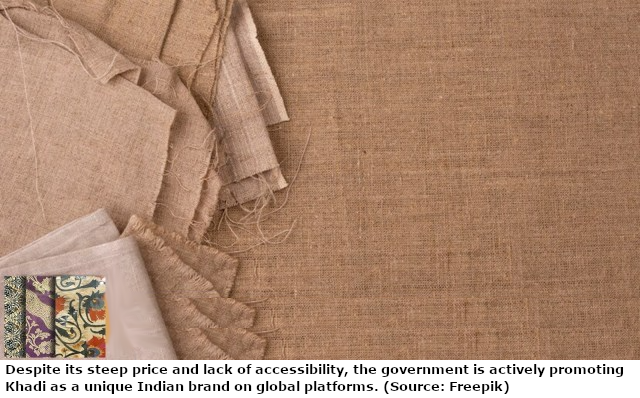
Category: FABRICS
Country: India
Region: South Asia
Embracing khadi is not just a fashion choice but a commitment to cultural preservation and economic empowerment.
By Ishika Roy, New Delhi
30th September, 2024 14:37 IST
5 min read
“Khadi is India’s answer to linen,” according to fashion designer Anju Modi. What began as a symbol of resistance against foreign rule, khadi, a hand-spun and handwoven textile native to India, has evolved into a beacon of climate consciousness and cultural preservation.
“Under British rule, mass-produced textiles devastated India’s handloom industry. Mahatama Gandhi promoted Khadi in the early 20th century, urging Indians to spin their textile as a form of economic resistance,” said Dr Adity Saxena, dean, School of Arts and Design, Woxsen University, Hyderabad. Derived from the Hindi word “Khad” or “Pit,” Khadi became central to the Swadeshi Movement.
Post-independence, its importance was institutionalised through the All India Khadi and Village Industries Board and the Khadi and Village Industries Commission (KVIC). Today, khadi is popular in neighbouring nations such as Bangladesh and Pakistan.
Khadi – a fabric or a textile?
“Simply put, all textiles are not fabrics, but all fabrics are textiles,” said Sugandha Suneja, assistant professor at NIFT Panchkula. In the case of khadi, it qualifies as both, though the terms are often used interchangeably. “Textile refers to woven or knitted materials made from yarn or fibers, which can be natural, man-made, or regenerated. Fabrics, on the other hand, are specifically created using methods like weaving, knitting, or crocheting,” she said.

Mahatma Gandhi weaving khadi on a spinning wheel. (Source: Wikimedia Commons)
Processes in khadi production
Khadi is hand-spun and handwoven on a charkha (spinning wheel) from cotton, silk, or wool threads. The process begins with collecting raw cotton, followed by ginning, carding, spinning, warping, and weaving. Once woven, the fabric is dyed using natural colors, and white pigment is used for printing. Each region in India offers distinct varieties of khadi.
Festive offer
“The finest type of khadi, with yarn counts of 100 or 120, are suited for lightweight summer clothing. Khadi with 500-1,000 counts used to be expensive, but is a rare find now due to its delicate production,” said professor Sanjay Guria, dean for academic affairs, School of Arts and Design, Woxsen University. Khadi of 20 counts are ideal for homeware, while finer yarns of 60-80 counts are used for garments.
Challenges faced by the industry
Khadi symbolises self-reliance owing to its association with the Swadeshi Movement, but its artisans face many challenges today. “Many skilled workers struggle with low wages and harsh conditions, triggering a shift away from this labour-intensive craft to more lucrative options. This exodus threatens the fabric of local communities and their traditional arts,” said Asha Patil, founder of Banjara Kasuti.
Khadi’s handspun yarn makes weaving difficult, leading to inconsistencies in dyeing, and shrinkage, explained Dr Saxena. Khadi production faces multiple challenges as well. This has led to an unfortunate reliance on subsidies, outdated marketing practices, low product innovation, shortage in funding, and unsold stock.
Weavers are also faced with the challenge of actively marketing their production because of the old system of trade, where most of the weavers work as daily wagers. “They depend on selling their product to earn the product value and reinitiate the loom only after the sale of the first product is made. However, brands are helping them with competitive wages and design inputs on upcoming trends, colours and fashion forecasts to make their job easier,” said Nishant Malhotra, founder & CEO, WeaverStory.
The rising popularity of khadi
Patil believes that khadi is experiencing a renaissance, particularly among millennials. “Its eco-friendly properties and versatility—keeping us warm in winter and cool in summer—have made it increasingly popular,” she said. This resurgence goes beyond fashion; it’s a celebration of indigenous identity and craftsmanship, deeply rooted in tribal communities that have preserved their textile arts for centuries.
“Since the 90s, Khadi has transformed into a fashion statement, with Indian designers experimenting to make it high fashion, now worn by celebrities and politicians. Designers blend khadi with silk, linen, and denim for softer textures, creating modern styles like crop tops and jackets. Bold prints add a fresh aesthetic,” said Professor Guria.
Despite steep prices and limited accessibility, the government actively promotes khadi as a unique Indian brand globally. With growing interest in sustainability, khadi’s handmade, eco-friendly process resonates with younger, eco-conscious consumers. Collaborations with global brands also make it as trendy and accessible as streetwear.
By bridging the gap between traditional craftsmanship and contemporary fashion, Patil believes we can help sustain this invaluable heritage while providing stable livelihoods for artisans. To her, embracing khadi is not just a fashion choice but a commitment to cultural preservation and economic empowerment.
Courtesy: Indianexpress.com
Copyrights © 2026 GLOBAL TEXTILE SOURCE. All rights reserved.